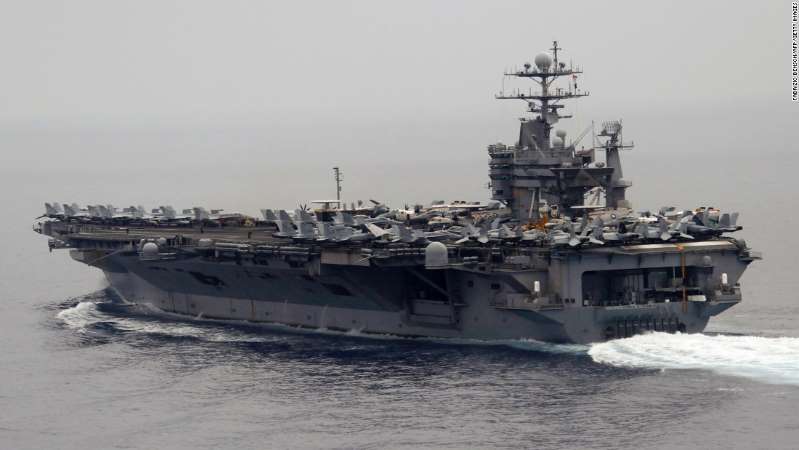By Barbara Starr, CNN Pentagon Correspondent–
The Pentagon has rejected a request from the US Central Command for additional military resources in the Persian Gulf to beef up US deterrence against Tehran, according to two defense officials.
The request comes at a time when there are concerns the Iranian regime could potentially lash out militarily in response to the US reimposing sanctions on the country. It also comes as Defense Secretary James Mattis and Gen. Joseph Dunford, chairman of the Joint Chief of Staff, are engaged in high-level classified discussions with senior commanders around the world about how to allocate military resources for the next two years, officials say.
It’s unknown publicly what exactly Gen. Joseph Votel, the four-star head of Central Command, asked for, but it’s known that CENTCOM would like to see an aircraft carrier return to the Gulf in the coming months, as one has not been there since winter.
Dunford said Monday that the balancing of resource allocation is one of the toughest jobs in the military and it can disappointment some combat commanders.
“That is one of the more important tasks we face, is to prioritize and allocate resources in accordance with the strategy,” he said. “And … if you look at what the combatant commanders would identity as their requirements, our inventory falls short of meeting all of what the combatant commanders would want to have, so the art for us is to have enough of our forces forward to demonstrate commitment, assure our allies, to demonstrate the ability to respond — which enhances deterrence — and then have the inherent flexibility in the force to get the right amount of forces in the right place, at the right time in the event deterrence fails.”
He added, “That’s the art of what we call global force management but it’s the art of, really, priorities and allocating our resources against the strategy.”
Officials say there is no intelligence indicating Iran is planning a military attack in response to sanctions being reimposed, but they also say the US doesn’t have a clear and detailed understanding of how the Iranian government might react. That lack of clarity is one reason Central Command wanted some additional resources for deterrence.
This summer, Iran conducted naval exercises to demonstrate its ability to close the Strait of Hormuz. Mattis said at the time, “Clearly, this would be an attack on international shipping, and — and it would have, obviously, an international response to reopen the shipping lanes with whatever that took.”
Votel has not disputed the decision publicly. He and other battlefield commanders are well aware the new Pentagon priority is to focus on China and Russia.
In a statement, Lt. Col. Earl Brown — chief of media operations for CENTCOM — said the US will have the ability to “respond to any contingency” but wouldn’t directly comment on the request for additional resources.
“CENTCOM has the forces we need to prosecute the ongoing fight to defeat ISIS, to support the Government of the Islamic Republic of Afghanistan in their fight against the Taliban, to pursue violent extremists, to deter potential adversaries and to respond to any contingency,” Brown said in the statement to CNN. “While we are not going to discuss the movement of specific forces into and out of the region, the U.S. has repeatedly demonstrated the ability to rapidly deploy and mass forces whenever and wherever they are needed in a time of crisis.”
For example, the aircraft carrier Harry S Truman has been in the North Atlantic for several weeks, as a visible signal to Russia, rather than possibly going to the Persian Gulf, which might have been a more traditional deployment.
Commanders in the past have been refused assets if there are competing priorities, and there is no indication Votel has sounded an immediate alarm about Iran. But to deter Iran, and have additional capability on hand to reduce the risk of the Islamic Republic making a decision to attack, there is a sense in military circles that more assets are needed.
This deterrence effort against Iran is not aimed at targeting its nuclear programs, per se. Officials say there is sufficient capability to surge and build up forces in the event the President were to order a strike against nuclear sites.
But the worry centers more on Iran’s capacity to potentially deny access to Persian Gulf shipping lanes and whether the US could mount a rapid response to keep those lanes open.
For example, the Pentagon estimates Iran could have as many as 1,000 small boats that could lay mines in the water and shut down shipping lanes within days. There are four American and four British minesweepers constantly stationed in Bahrain, but they could not immediately be used, officials say. First, the US would have to deal with potentially thousands of Iranian coastal defense missiles, as well as cruise and ballistic missiles that can strike neighboring countries that would provide crucial ports and airfields.
This comes as the US has taken four Patriot batteries out of the region that are critical for defending against ballistic missiles: two from Kuwait, one from Jordan and one from Bahrain.


Leave A Comment
You must be logged in to post a comment.